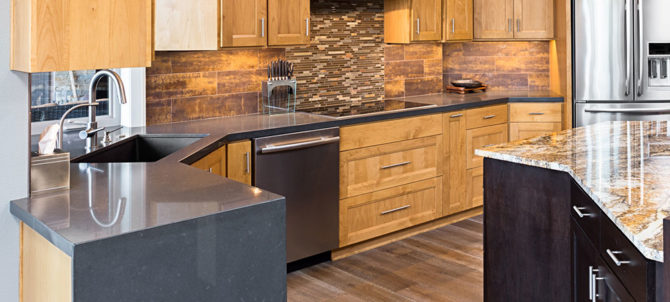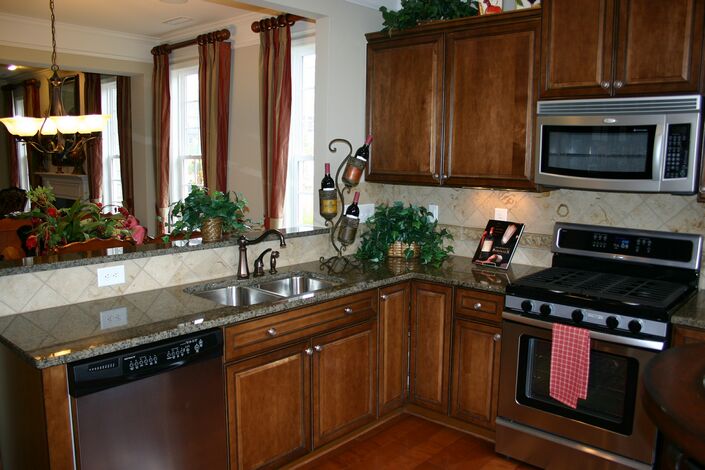
When you install granite countertops, you want them to retain their smooth and shiny look for as long as possible, right? The cool thing is that it’s possible. Some of the things you need to do include:
Protect your countertops from damage
The easiest way to keep your granite countertops in good condition is to protect them from spills, stains, and scratches.
The kitchen can be dirty, so it’s critical to take precautions to safeguard it. Some of the basic techniques to protect your granite kitchen surfaces include:
- Clean spills immediately.
- Use coasters
- Cut veggies and other foods on cutting boards.
- Avoid placing hot pots and pans directly on your countertop surface.
- Be cautious of impact damage around the edges.
- Avoid standard household cleaning agents, which can cause etching.
To protect your granite countertops from frequent stains and impurities, have them polished and sealed. Before you even do this, you must first ensure that you properly clean them.
How to clean granite surfaces
Different granite composites may require special treatments, so check with experts before trying new products.
Regardless of how clean you want the surfaces to be, never use cleaning agents with ammonia, vinegar, or citrus on your granite surfaces.
This is because these acidic cleaners will degrade the finish on your new granite countertop. You should purchase a cleaner made exclusively to clean granite surfaces.
To clean your granite countertops, spritz or mist the cleaner over the entire surface and allow it to sit for a minute. Remember to verify the exact instructions for the cleaner you’re using. Then, clean the surface with a soft microfiber cloth until completely dry.
Get rid of stubborn stains.
If cleaning does not work, you may need a razor blade to remove stubborn stains. Use the blade to scrape off any filth or buildup on the countertop.
You should be cautious when using the blade so you don’t scratch the surface. Simply ensure that the entire edge of the blade is on the counter.
Once satisfied, rinse your sponge and remove the suds.
You may need to rinse your sponge, wring it out, and wipe up any remaining suds several times. Make sure there are no huge puddles or leftover suds on your counters.
To be on the safe side, wear gloves to protect your hands.
If you don’t have a razor blade, you can remove tough granite stains by making baking soda and water paste. Scrub the spot gently with the paste and a soft towel.
Remember to rinse it well.
Removing a difficult stain may take numerous attempts, so don’t be afraid to go over it a couple of times. For a stubborn stain, apply the paste to the area, cover it with plastic wrap, and tape it down the corners.
Let the paste sit until it dries, which can take several days. When it has dried, use a soft cloth to remove it, then rinse with warm water.
Polish the surfaces
Polishing your granite countertops is similar to cleaning them. However, this time, you will allow a polishing solution to sit for 3 to 4 minutes before cleaning it away.
Once you are done, rub the countertop with a soft cotton towel until no streaks are left. At the end, you should be left with dazzling granite countertops you can be proud of.
You can polish granite using dry or wet materials. There is no better method as both methods can be beneficial. When making your choice, consider the advantages and disadvantages of each. For example,
- Dry granite polishing powder costs less than paste.
- You can apply dry and wet powder, making it more versatile.
- Wet polishing produces a lot of spray when used with power tools, so you should wear water-resistant gear to protect yourself.
- When polishing the surfaces, use plastic sheeting to cover walls, furniture, and cupboards.
- Wet polishing cools the pads, preventing them from getting too hot and wearing out faster than they should.
- Wet polishing pads cost less than dry pads.
If you are unsure about the ideal polishing material, contact your countertop manufacturer. They will recommend the best material.
Seal your countertops
A properly sealed granite surface will slow the spread of stains.
Pour a small amount of water on your granite surfaces to tell whether your countertops are ready for sealing. If you detect it slowly seeping in or darkening the surface of your granite, it’s probably time to reseal.
If the water immediately beads up on the surface, it indicates that you do not need to seal your granite countertops just yet.
When evaluating your granite sealer, apply it to a less obvious location before applying it to the rest of the countertop.
When applying the sealer, you should work in tiny portions to avoid spraying the same area many times. After applying the sealant, wipe off the countertop surface with a soft cotton towel for 3 to 5 minutes until dry.
After that, your countertops should be ready to use.
Add shine to the surfaces.
To shine your granite, apply a small amount of cooking oil to a soft cleaning cloth and wipe it around the surface. Buff it carefully. This makes the counter a little more stain-resistant and gives it a glossy finish that you are looking for.
Parting shot
These are some of the things you should do to keep your granite kitchen countertops Durham smooth and shiny.
Remember that everything begins with how you use the countertops. You won’t have an easy time if you don’t take good care of the surfaces. As a rule of thumb, always use a coaster on the surfaces.
Stains are bound to happen regardless of how frequently you clean your countertops. To avoid this, make it a habit to seal the surfaces. You can seal the surfaces by yourself, but always ensure that you use high-quality sealing products.


